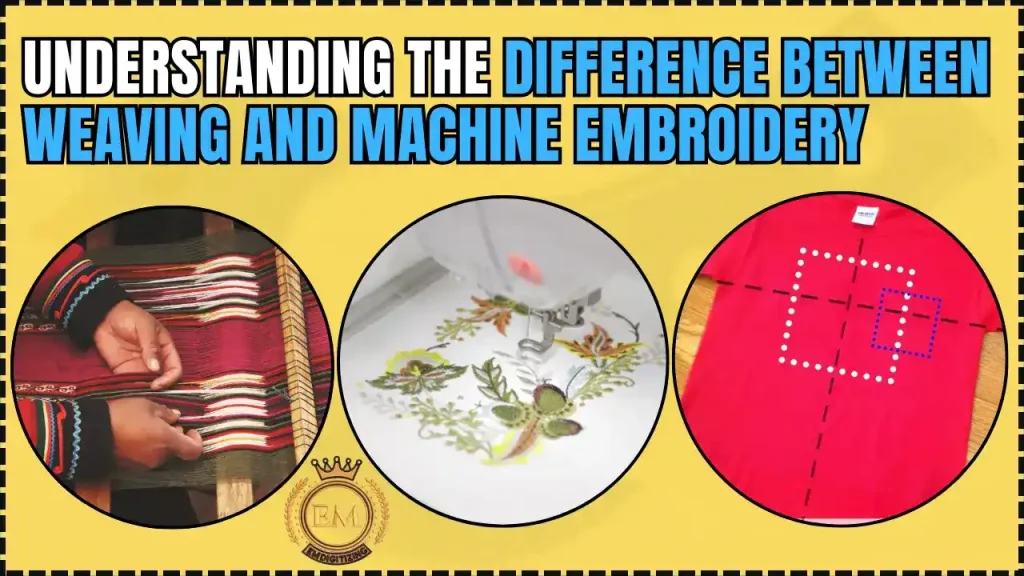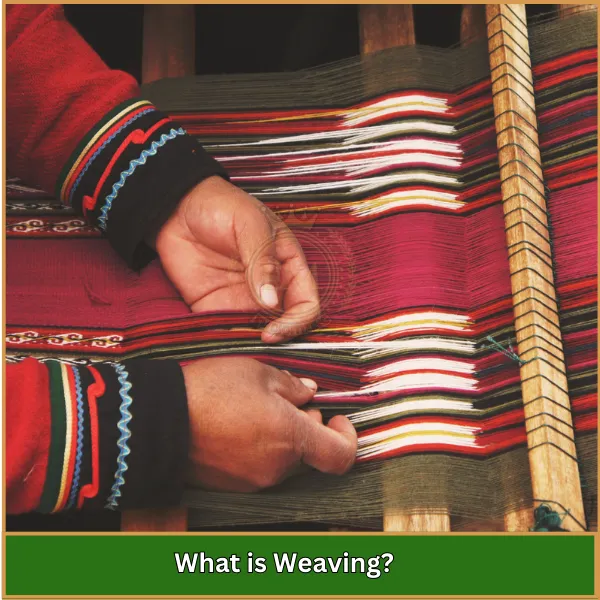¿Sabes qué diferencia al tejido y al bordado a máquina en el universo textil??
Tejer es el proceso clásico de entrelazar hilos para construir telas desde cero, esencialmente, así es como los hilos crudos se transforman en tela.

Mientras tanto, El bordado a máquina implica coser patrones intrincados en una tela existente., elevándolo con diseños decorativos y coloridos. Estas técnicas dan forma al mundo de los textiles de maneras únicas., contribuyendo a todo, desde lonas resistentes hasta delicadas sábanas bordadas..
Let’;Profundicemos en las características y aplicaciones distintivas de cada uno para comprender su impacto en nuestros textiles cotidianos..
Comprender la diferencia entre tejer y bordar a máquina
que es tejer?

El tejido es un método de producción textil que implica entrelazar dos conjuntos de hilos: urdimbre. (longitudinal) y trama (lateral)—en ángulos rectos para crear tela. Este proceso normalmente se lleva a cabo en un dispositivo llamado telar..
Tipos de tejido
Hay varios tipos de tejido., cada uno con sus propias características y usos.
1. Tejido liso
- Los hilos se alternan uno encima del otro.
- Ejemplos: Muselina, gasa.
- Características: Superficie duradera y plana.
2. Tejido de sarga
- Crea un patrón diagonal pasando la trama por encima y por debajo de varios hilos de urdimbre..
- Ejemplos: Mezclilla, pata de gallo.
- Características: Fuerte y resistente a las arrugas.
3. Tejido satinado
- Múltiples hilos de trama pasan sobre menos hilos de urdimbre, dando como resultado una superficie brillante.
- Ejemplos: Satín, la lluvia.
- Características: Sensación de lujo, menos duradero.
4. tejido de cesta
- Utiliza pares de hilos en ambas direcciones para crear un patrón de tablero de ajedrez..
- Características: A menudo se utiliza en tapicería..
5. Tejido jacquard
- Crea patrones complejos usando un telar especial..
Ejemplos: Brocado, damasco.
6. Tejido de gasa o gasa
- Pares de hilos de urdimbre se entrelazan entre sí para crear una tela abierta..
Características: Ligero y aireado.
Ventajas y desventajas de tejer
Se ha utilizado durante siglos para crear tejidos., y como cualquier técnica, tiene su propio conjunto de ventajas y desventajas según el material y el propósito.
Ventajas
- Durabilidad
- Variedad de texturas
- Rentable para la producción a granel
Desventajas
- Complejidad de diseño limitada
- Configuración que requiere mucho tiempo
- Requiere mano de obra calificada
¿Qué es el bordado a máquina??

Es un método para decorar telas utilizando una máquina de coser o un taller especializado. Maquina de bordar para crear patrones y diseños intrincados.
Esta técnica permite una alta precisión y consistencia., haciéndolo popular tanto en aplicaciones comerciales como personales.
Se puede utilizar para la marca., fines decorativos, y crear artículos personalizados.
Tipos de bordado a máquina
Hay varios tipos de bordado a maquina, cada uno adecuado para diferentes aplicaciones y necesidades.
1. Bordado a máquina de movimiento libre
- Utiliza una máquina de coser en zigzag estándar..
- El operador mueve manualmente la tela debajo de la aguja para crear diseños..
- Cada diseño es único y no se puede reproducir fácilmente..
2. Bordado a máquina computarizado
- Se trata de máquinas controladas por una computadora..
- Los diseños están preprogramados y se pueden ejecutar automáticamente..
- Elimina la necesidad de volver a enhebrar manualmente los diseños multicolores.
3. Máquina de bordar de un solo cabezal
- Diseñado para tiradas de producción más pequeñas.
- Cuenta con un cabezal que puede bordar un artículo a la vez..
- Ideal para piezas personalizadas o pedidos pequeños.
4. Máquina de bordar de cabezales múltiples
- Contiene múltiples cabezas, permitiendo el bordado simultáneo en varias prendas.
- Eficiente para la producción a granel manteniendo la calidad.
5. Máquina de bordar Schiffli
- Utiliza múltiples agujas que penetran la tela simultáneamente..
- Comúnmente empleado para producir diseños complejos en encajes y textiles similares..
6. Bordado guiado a mano por Cornely
- Requiere un operador para guiar la máquina manualmente..
- Produce puntadas especiales como puntadas de cadena y puntadas de satén., A menudo se utiliza en aplicaciones de diseño de interiores..
Ventajas y desventajas del bordado a máquina
Es una forma rápida y precisa de agregar diseños a la tela., pero también tiene sus propios pros y contras dependiendo de las herramientas y técnicas utilizadas..
Ventajas
- Alta precisión y consistencia
- Velocidad
- Versatilidad en el diseño
Desventajas
- Costos iniciales más altos
- Menos toque personal
- Complejidad en la programación
Diferencia entre tejido y bordado a máquina
El tejido y el bordado a máquina tienen diferentes roles en la industria textil., Cada uno utiliza sus propios métodos y resultados.. Aquí están las principales diferencias.:
- Técnica de producción
- Objetivo
- Equipo utilizado
- Flexibilidad de materiales
- Ubicación del diseño
- Conjunto de habilidades
- Producto final
- Complejidad del patrón
- Velocidad de producción
- personalización
1. Técnica de producción

Tejido y bordado a máquina: Tejer implica entrelazar dos conjuntos de hilos o hilos en ángulo recto entre sí para crear tela..
Este método se basa en un telar y el proceso puede producir textiles que van desde simples telas de algodón hasta complejos tapices..
Bordado, por otra parte, Implica el uso de una aguja e hilo para agregar puntadas decorativas a una base de tela., a menudo después de haber tejido la tela.
2. Objetivo
El tejido tiene como objetivo principal crear telas a partir de hilos o hilados.. El bordado se utiliza para embellecer la tela con patrones o imágenes., mejorar el valor estético y, a veces, funcional del material con color adicional, textura, y diseño.
3. Equipo utilizado

El principal equipo para Tejido y Bordado incluye telares para tejer., que pueden ser simples marcos operados manualmente o complejas máquinas automatizadas.
El bordado utiliza máquinas especializadas que pueden manejar múltiples hilos y colores, Diseñado para aplicar diseños complejos sobre tela..
4. Flexibilidad de materiales
Para tejer normalmente se utilizan materiales como hilos de algodón., lana, seda, o fibras sintéticas diseñadas para formar tejidos duraderos. Los materiales de bordado incluyen no solo hilos tradicionales sino también hilos especiales como los metálicos., gorra y chaquetilla de jockey, y los utilizados en bordado y tejido de cuentas para agregar textura y detalles decorativos..
5. Ubicación del diseño

en tejer, Los elementos de diseño deben planificarse e integrarse en la tela a medida que se crea en el telar.. El bordado permite la aplicación del diseño después de la producción del tejido., proporcionando flexibilidad para agregar ilustraciones personalizadas y detalladas en cualquier parte del material existente.
6. Conjunto de habilidades
Tejer requiere una comprensión de la mecánica del telar., así como la capacidad de configurar patrones y gestionar la tensión y entrelazado de hilos.. El bordado exige habilidades en la digitalización del diseño, configuración de la máquina, y el manejo de diversas técnicas de costura para lograr los efectos artísticos deseados..
7. Producto final
Los productos del tejido son textiles que forman los componentes básicos de otros productos., como prendas de vestir y muebles para el hogar. Los artículos bordados a menudo representan productos terminados., presentando un atractivo visual mejorado con superficies decoradas.
8. Complejidad del patrón
La complejidad del patrón en el tejido está limitada por las capacidades del telar y puede ser geométrica y repetitiva.. El bordado ofrece una gama más amplia de posibilidades., permitiendo diseños muy detallados y elaborados que pueden incluir diferentes patrones de puntadas, gradientes, y complejidad similar a la de una imagen.
9. Velocidad de producción
El tejido puede producir grandes cantidades de tela con relativa rapidez, especialmente con telares automatizados modernos. Bordado, trabajo especialmente detallado, lleva más tiempo, centrándose en el detalle meticuloso por encima de la velocidad, Lo que lo hace menos eficiente para la producción de telas a gran escala, pero es ideal para creaciones artesanales y a medida..
10. personalización

El tejido ofrece opciones de personalización limitadas que dependen en gran medida de la configuración del telar y de los hilos utilizados.. El bordado ofrece amplias oportunidades de personalización., permitiendo una amplia gama de colores, diseños, y toques personales que se agregarán a cualquier tejido después de haber sido tejido.
Decidir entre tejer y bordar a máquina para sus proyectos
A la hora de decidir entre estas técnicas para tus proyectos textiles, considere los siguientes puntos:
Propósito del Proyecto:
- Utilice el tejido si necesita crear tela desde cero: ideal para crear textiles con características específicas como el grosor., durabilidad, y textura.
- Choose machine embroidery if you’;Estamos buscando agregar detalles decorativos a la tela existente., perfecto para diseños personalizados o marcas.
Requisitos del proyecto:
- El tejido le permite adaptar los aspectos fundamentales de su tejido., adecuado para aplicaciones que requieren la creación de material personalizado.
- El bordado a máquina realza y embellece la tela con colores, patrones intrincados, ideal para proyectos artísticos o branding comercial..
Comprender lo que ofrece cada proceso le ayudará a tomar la mejor decisión para sus necesidades específicas., whether you’;Volver a crear una nueva tela o mejorar la existente con hermosos bordados..
Ultimas palabras
Con una comprensión clara del tejido y el bordado a máquina., es fácil ver cómo el bordado añade un toque especial a cualquier tejido. Si está buscando agregar diseños personalizados a su proyecto, EMDigitalización puede hacer que el proceso sea simple.
Ofrecemos alta calidad servicios de digitalización que transforman su obra de arte en archivos de bordado listos para coser. Nuestros servicios son rápidos, confiable, y asequible.
Más, como nuevo cliente, obtendrás un increíble 50% fuera de tu primer orden! Comience con EMDigitizing y observe cómo sus diseños cobran vida sin esfuerzo.
preguntas frecuentes
Coser se refiere al uso de una aguja e hilo para unir piezas de tela o para crear diseños decorativos en la tela.. Tejeduría, por otra parte, es el proceso de entrelazar dos conjuntos de hilos, la urdimbre y la trama, en ángulo recto para formar una tela.
Hay dos tipos principales de bordado a máquina.: bordado de movimiento libre, donde el usuario controla manualmente la costura en una máquina de coser básica, y bordado computarizado, que une automáticamente diseños digitalizados usando una máquina de bordar especializada.
Tejer es el proceso de hacer tela entrelazando dos conjuntos distintos de hilos o hilos., llamado urdimbre y trama, en un telar.
El bordado a máquina es un método para crear patrones en tela usando una costura o Maquina de bordar. Los diseños están preprogramados en la máquina., que los cose automáticamente sobre la tela.
